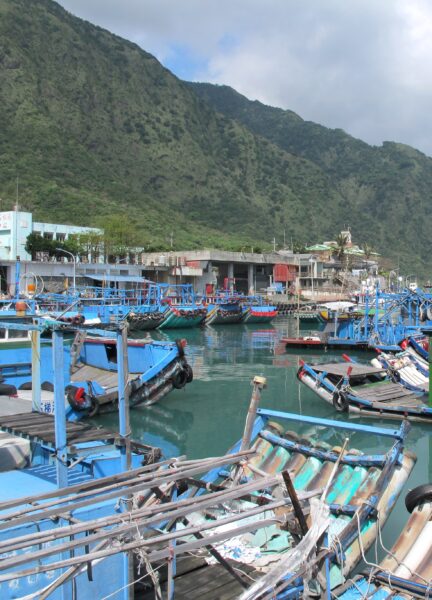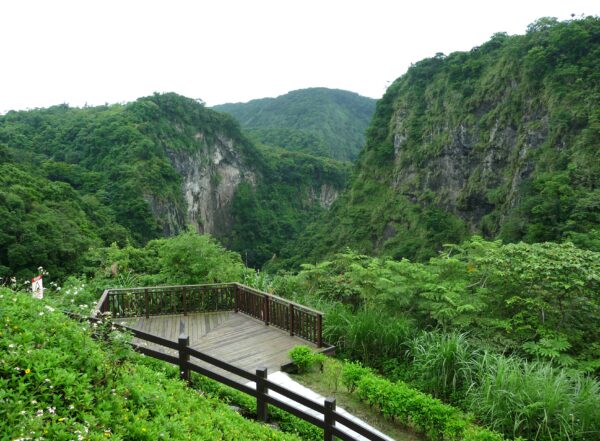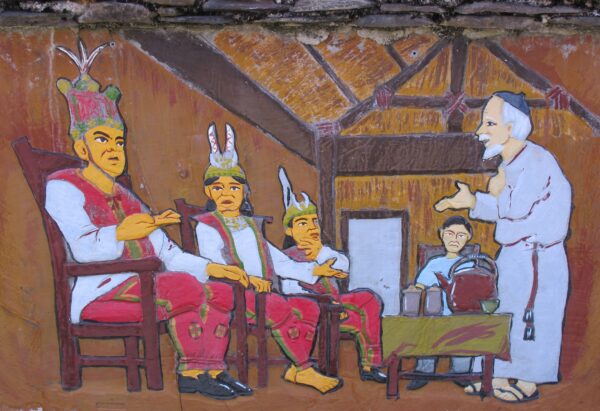Travellers heading to Taiwan’s lush eastern region have three options, broadly speaking. They can drive slowly from Hualien City to Taitung City along the sparsely populated coast. They can travel by car or train through the East Longitudinal Valley (which older sources refer to as the East Rift Valley). Or, even better, they can set aside four or more days and do both.

Shitiping’s fishing harbour
In the third part of our occasional series about the diverse national scenic areas designated by Taiwan’s Tourism Administration, this time we’re focusing on the seaside route and the multiple attractions within the East Coast National Scenic Area. Stretching 170 km (106 miles) along Taiwan’s eastern flank, from the mouth of the Hualien River in the north to Xiaoyeliu in the south, the scenic area is bounded by the mile-high peaks of the Coastal Mountain Range to the west and the vast Pacific Ocean to the east. The part of Taiwan, which encompasses parts of both Hualien County and Taitung County, is both a geological marvel and a cultural tapestry, offering visitors an unparalleled immersion in nature and rich Austronesian cultures.
No hiding from the forces of nature
The landscape here has been sculpted by colossal forces. Because it lies at the convergence of the Eurasian and Philippine Sea Plates, tectonic forces continue to drive the Coastal Mountain Range upward at an annual rate of 9 to 14 mm (between a third of an inch and just over half an inch per year). At the same time, relative to the Central Mountain Range, the coastal mountains are meandering to the northeast.
Coastal erosion is another factor. In Hualien’s Fengbin Township, more than 100 plots of land have collapsed into the ocean since the start of the 21st century. Some of the owners say that where they used to farm, they have to fish if they want to get food from their land.
Hualien City is a bustling urban centre with almost 100,000 inhabitants. It has a good selection of hotels, several highly-recommended restuarants, and a number of interesting sights. The global headquarters of the Buddhist Compassion Relief Tzu Chi Foundation, Taiwan’s biggest charity in terms of membership, welcomes visitors, as does the Indigenous Wild Vegetable Centre. Founded by an Amis woman who has dedicated years to the preservation of tribal recipes and foraging knowledge, the latter can provide an English-language tour if given plenty of warning.
Stargazing and whale watching

Whirlpool Galaxy photographed from Hualien (Copyright Joe Garrity)
Taking the coast road (Highway 11) south leads to Yanliao where there’s a fishing harbour, a coastguard station, and not a lot else. On clear summer nights, it attracts a small but devoted crowd of stargazers, because the light pollution that’s inevitable on an island as densely populated and developed as Taiwan falls off dramatically. On the nine-level Bortle scale, it’s ranked as Class 3, meaning a lot is visible even if some artifical light is evident at the horizon. On a good night there are glorious views of the Milky Way.
Ocean-loving visitors may want to sign up for a whale-watching excursion. Between April and October, sightseeing boats sail from the harbours in Hualien, Chenggong, and Yilan and search for some of the 31 cetacean species that have been recorded off the coast of Taiwan. If they’re lucky, those on board get to see killer whales, pygmy killers, and maybe even a sperm whale. They’ve an excellent chance of also encountering Risso’s, Fraser’s and common bottlenose dolphins.
The companies that operate these tours (which last around three hours) usually cater to local tourists but Life of Taiwan can make all the necessary arrangements on your behalf, ascertain if there’ll be an English speaker aboard who can explain what you’re seeing, and ensure that you’re collected from and returned to your hotel. The vessels are quite small, so don’t eat beforehand if you’re prone to seasickness!
The slow drive southward

Ravine scenery at Fanshuliao
Continuing south, heading to Taitung, there’s a place called Fanshuliao. Liao means ‘hut’ — the aforementioned Yanliao is literally ‘salt hut’ — while fanshu is an old and politically-incorrect name for sweet potatoes, so it’s reasonable to assume that sweet potatoes were farmed and/or stored here in the past. Hardly anyone lives hereabouts but if you’ve your own vehicle, you’ll probably want to make a brief stop to see the 70-m-deep (230 ft) gorge, and then stop again at Baqi Viewing Platform to gaze out over the bay.
Forty minutes south of Baqi, there’s the fishing community of Shitiping. In case you‘re wondering, this place name should be read ‘shi-ti-ping’ and it means ‘stone ladder terrace’. The geological environment is a combination of uplifted coral reefs and long-cooled volcanic outpourings. Find a place to sit, gaze out to sea, turn occasionally to look at the rugged green slopes behind you, and relax!
The final settlement before entering Taitung County is clustered around the mouth of the Xiuguluan River, which also happens to be the terminus of Taiwan’s most popular whitewater rafting route. Those getting around by bus will almost certainly have to change buses here, which can involve a longish wait without much to do. No such delays for those on a private tour with their own driver-guide, of course!
Taiwan’s ancient people

Indigenous motifs inside a Catholic church, Taitung
You may not want to stop at Baxian Caves but it’s worth knowing what was discovered at this site of tremendous archaeological significance. It’s Taiwan’s only confirmed Palaeolithic site, inhabited between 5,000 and perhaps 25,000 years ago when the caves were a lot closer to the ocean, before tectonic uplift raised them as much as 130 m (427 ft) above sea level. Excavations since the 1960s have recovered stone and bone tools, fish bones left over from meals, and — most remarkable of all — rubbing sticks used millennia ago to make fire. Scholars still aren’t sure if there’s any connection between these ancient inhabitants and the Austronesian indigenous people whose cultures are now a key part of the region’s appealing character.
Baxian Caves are named after the Eight Immortals that feature prominently in Taoism, and some 35 km (22 miles) to the south, Sanxiantai is named for three of the eight. An alluring section of coast, Sanxiantai deserves an hour of your time, after which you may want to stop in the little town of Chenggong and sit down for a meal. At the end of each autumn, Chenggong’s fishermen use harpoons to catch black marlin which are sold on to upmarket restaurants in Taipei or Japan. Lovers of seafood need not fret, however — there’s plenty of fresh and delicious marine produce to be eaten here if you (or your guide) knows where to find it.
Dulan is a very different place to Chenggong. Its personality comes not from the saltiness of the sea but from the sweetness of sugar and the creativity of artists. The old sugar refinery was closed down decades ago and eventually repurposed into a place where creatives could show and sell their works. The population is now a mix of local Amis, art lovers from all over, and couples who’ve turned their backs on big-city life and now run tourist-focused businesses.
The drive from Dulan into Taitung City can take less than half an hour — but there’s a good chance you’ll want to stop in Xiaoyeliu and/or Fugang. The former is yet another spot where you can marvel at gorgeous coastal rock formations. The latter is a small fishing community best known as the gateway to Green Island and Orchid Island.
Whatever your interests and priorities, Life of Taiwan’s expert itinerary designers can plan out a schedule that meets your dietary and accommodation standards while moving neither too fast nor too slow. Contact us today so we can discuss your Taiwan holiday of a lifetime!
